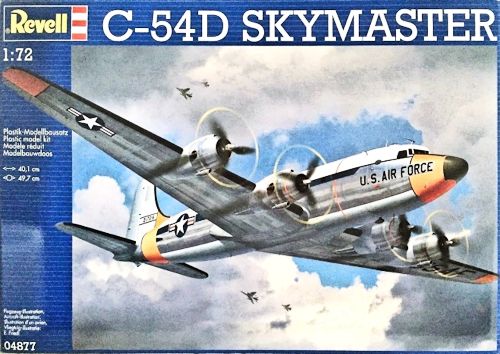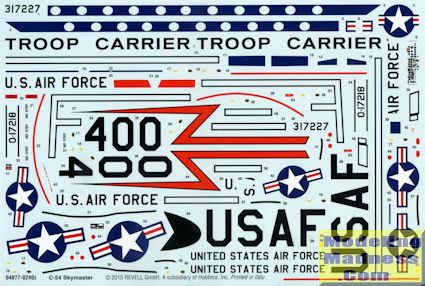
Revell 1/72 C-54D Skymaster
| KIT #: | 04877 |
| PRICE: | $49.95 SRP |
| DECALS: | Two options |
| REVIEWER: | Scott Van Aken |
| NOTES: | New tool kit |

| HISTORY |
The Douglas C-54 Skymaster was a four-engined transport aircraft used by the United States Army Air Forces in World War II and the Korean War. Like the Douglas C-47 Skytrain, the C-54 Skymaster was derived from a civilian airliner (the Douglas DC-4).
Besides transport of cargo, the C-54 also carried presidents, prime ministers, and military staff. Dozens of variants of the C-54 were employed in a wide variety of non-combat roles such as air-sea rescue, scientific and military research, and missile tracking and recovery. During the Berlin Airlift it hauled coal and food supplies to West Berlin.
After the Korean War it continued to be used for military and civilian uses by more than 30 countries. This was one of the first aircraft to carry the President of the United States.
Over 1100 were built, many seeing service after military use either as rehabbed airliners or as cargo operators. They have also been used as aerial sprayers and at least one C-54G was still active as a fire bomber in 2015.
| THE KIT |
 Revell's
kit has been much anticipated by fans and the wait seems to be well worth it.
Prior to this, the only injected plastic C-54/DC-4 was the excellent Minicraft
kit, still readily available though in the smaller 1/144 scale. There have also
been vacuforms in various scales.
Revell's
kit has been much anticipated by fans and the wait seems to be well worth it.
Prior to this, the only injected plastic C-54/DC-4 was the excellent Minicraft
kit, still readily available though in the smaller 1/144 scale. There have also
been vacuforms in various scales.
The box is quite large and when you open it you will see a ton of sprues. Very few of the parts are not used and I am sure that we will see other boxings. The kit offers a full cockpit, radio/nav room and a complete cargo area. The cargo area has jump seats along side the walls in the lowered position. For those wanting to haul cargo only, I'm sure the seats could be eliminated and the mounting holes filled.
Similar to their Ju-52, the kit has a separate interior fuselage. This is where the majority of the inside bits are attached. There are engravings on the side of these interior walls if you wish to build the model with the cargo door open, showing what you need to cut away. This engraved area also shows just a single passenger door, intimating that a passenger version may be in the works. On the left fuselage half, the cargo door piece is a separate insert.
Considerable detail is included in the forward fuselage and it takes over two full pages in the instructions to cover it. There are even the crew rest cots in the radio/nav compartment. How much of this you will actually see when the fuselage is closed is unknown to this reviewer, but there is a right side cockpit door that can be posed open. As you expect, there is a ton of sidewall detailing for both the crew and cabin areas. The instructions recommend ten grams of weight and it will take a bit of work to find somewhere to put it as much of the lower nose is taken up with the nose gear well. Revell wants you to completely assemble the nose gear prior to cementing the fuselage halves together.
The wings are a single lower piece with two upper sections. There are separate ailerons and flaps. The flaps can be displayed lowered, which is standard on the ground. The kit offers an 'in flight' building option as well if you wish this feature. I have to say that the instructions are quite confusing when it comes to the flaps. I'm not sure if you need to cut away sections to have the flaps lowered or if this is to have them raised. The engine cowlings are complete forward units with separate cowl flaps. The exhaust system is all nicely detailed so when you look into the open cowl flaps, you'll see it. You also have a closed cowl flap option. Main landing gear is quite complex as on the real aircraft and you'll soon see that the C-54 has its share of main gear doors.
Horizontal stabilizers have separate elevators and there is a separate rudder. From the look of it, there are also two separate nose sections, one which is larger and a bit more bulbous than the other. This latter version is for the radar nose. Revell provides a cockpit transparency that has the surrounding fuselage integrated into it. This is the perfect way to go with situations like this. The aircraft has a surprising number of antennas and other little bits to attach to the fuselage. These planes had dual HF radios and dual DF sense antennas that will require rigging the radio wires. In case you didn't put in enough nose weight, a tail stand is provided. This item was often used on these aircraft.
 Instructions
are generally well done aside from the confusing area I mentioned. All paints
are Revell so mixing will be required for some. The markings are for two planes.
One is the box art plane with fluorescent areas on the nose, fuselage and wings.
These areas will have to be painted. The US Air Force, United States Air Force,
and USAF are in black when they should be insignia blue. The other plane isn't
as colorful, but very much looks like one that participated in the Berlin
Airlift. Both schemes are from 1949. The large decal sheet itself is very nicely
printed. I fully anticipate several aftermarket sheets for this kit as the plane
saw such widespread service. Personally, I'd like a French one!
Instructions
are generally well done aside from the confusing area I mentioned. All paints
are Revell so mixing will be required for some. The markings are for two planes.
One is the box art plane with fluorescent areas on the nose, fuselage and wings.
These areas will have to be painted. The US Air Force, United States Air Force,
and USAF are in black when they should be insignia blue. The other plane isn't
as colorful, but very much looks like one that participated in the Berlin
Airlift. Both schemes are from 1949. The large decal sheet itself is very nicely
printed. I fully anticipate several aftermarket sheets for this kit as the plane
saw such widespread service. Personally, I'd like a French one!
| CONCLUSIONS |
If you have built ANY of the Revell AG's large aircraft kits in the last dozen or so years, you know the sort of detail level you can expect from this one. It is well worth the $50 retail price and those who shop around can get it for less. It will take a bit to build, but the end result will not only be something big, but impressive as well. When SAC gets the metal landing gear for this, buy it. I built Heller's 1/72 C-118 many years ago and broke the nose gear on that about a dozen times. I anticipate this one being about the same in that regard.
| REFERENCES |
https://en.wikipedia.org/wiki/Douglas_C-54_Skymaster
September 2015
If you would like your product reviewed fairly and fairly quickly, please contact the editor or see other details in the Note to Contributors.